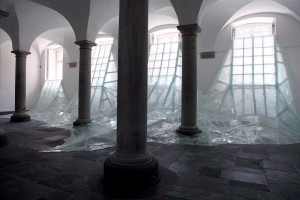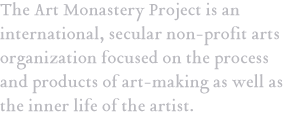Skip down to the full list of Elements.
Open-Source Monastic Technologies
[Artmonk Nathan Rosquist wrote this originally for the online Art & Monasticism Symposium, April 30 – May 5, through Transpositions, a collaborative effort of students associated with the Institute for Theology, Imagination, and the Arts at the University of St Andrews.]Stepping a few paces back from the religious worlds of the West and East, we begin to see the contours that define them. We notice structures that are wholly unique, as well as patterns that repeat from tradition to tradition. One of the patterns we can make out clearly, although with a great deal of variation and localized ornamentation, is monasticism—that tendency for serious practitioners of a religious tradition to band together and avail themselves of the efficiencies that come from living in a disciplined community.
 [/media-credit]
[/media-credit]Clearly there are economic efficiencies. It’s easier to survive as a community, in which specialization becomes possible, than alone; some monks are good at holding the big picture, while some monks are better at painting icons, and others are virtuosos at cooking nourishing meals, or farming, or carpentry, or web design. There are efficiencies that have to do with spiritual practice as well. It is much easier to hold a daily routine of work and contemplation when you do so with a group of like-minded brothers or sisters. And when singing or chanting, of course, it is only possible to make harmonies together.
From this perspective, monasticism starts to look less like something spiritual and more like a type of technology, an arrangement of hardware and software that has arisen in various places at various times to meet certain universal needs—for stable community and material support, as well as the sublime. We need the nectar of transcendence as much as we need more tangible kinds of nourishment, and monastic life is designed to provide both. Like technology, monasticism appears to evolve over time as groups’ needs change, and as social, cultural, political, and ecological climates shift from season to season. Some monastic hardware & software is better suited for north Africa in the 6th century, while another kind fits medieval Japan after the arrival of Buddhism, and a dozen others are appropriate to the array of niches in today’s post-modern religious world.
Here at the Art Monastery Project, we take the source code of this software, the blueprints of this hardware, and apply them to art-making and the creative process. Our goal, not totally different from that of some other monastic orders, is to cultivate personal awakening and cultural transformation through art, community, and contemplation. Thankfully for us, most monastic software is open source, freely available to anyone with eyes to see.
So how are we doing it? What monastic technologies are we using to run our art projects?
In terms of hardware, community is one of the biggest pieces. But a monastery, whether Benedictine or Kagyu, is not just any intentional community. As a structure in space, a monastery has intentionality designed into every square foot. As a structure in time, a routine that carries practitioners toward greater balance, compassion and wakefulness, a monastery must be flexible and free enough to adapt to changing circumstances and to give monks time to be quiet and still, yet rigid enough to keep monks active and productive. Thus an Art Monastery is not just your average artist colony. It is informed by the history of monastic architecture, as well as the routines that have guided monks for hundreds of years.
Monastic discipline is another piece of technology we apply to art-making. At certain times of the year we get up at the same time, work together to sustain ourselves as well as to make art (be it dance, music, theatre, painting, sculpture, performance art, etc….), and engage in contemplative activities like meditation, chant, and reading together throughout the day. Our meditations focus our minds and give us insights that we can apply to our individual or group creative work. In turn, the process of art-making benefits our progress along our personal spiritual path, which may differ greatly from Artmonk to Artmonk.
At an institutional level, we focus on practice as much as on product. We consider ourselves an alternative form of art institution, and thus prize new ways of thinking about art: as devotion, as offering, as gift, as sacred act, as ritual, as individual expression of the divine, as teacher, as priest, as sacred text, and as sacrifice. Similarly, we are an alternative economy for artists and Artmonks alike: we practice resourcefulness and community in order to liberate artists from the prevailing economics of art, one that either commodifies a work or disregards it as dangerous or political.
We apply monastic forms of governance to our community living: we experiment with monastic rules and vows. This year, for example, four of us have taken yearlong Artmonk Vows to practice gratitude, fidelity, and resourcefulness. We think about art as a lineage, or as a number of branching lineages, some of which are directly applicable to our vision of personal awakening and cultural transformation. Like other monastic traditions, we experiment with functional (rather than absolute) hierarchies. Each Art Monastery could have an Abbot or Abbess, as well as a spiritual director and an artistic director.
For the past three years, we have run three public and two private Artmonk Retreats, laboratories for connecting silent
Like many monasteries, we are interested in being both removed from the world and actively engaged to make it better through service and
This process is just a few years old, and we have much to learn. For example, even though we have been occupying a few rooms in a medieval monastery in Italy for the past couple of years, most of us have more experience with meditation retreats in Tibetan and Theravada Buddhist lineages than with the realities of western monastic life. And while the ideas for much of what we do are borrowed from other monastic sources, they often have to be rebuilt from the ground up to be useful and relevant to us. How can we honor tradition, even as we borrow from and adapt it to our unique mission?
These are the kinds of creative problems Artmonks love most.
The Elements of Monasticism: a growing Monastic ABC’s.
- Architecture – A building called a “monastery” (or abbey, friary, priory, charterhouse, hermitage, skete, lavra, matha, mandir, koil, gompa, lamasery, wat, vihara, or mahavihara) is designed with eco-efficiency and mindfulness in mind.
- Contemplation– e.g.
- Meditation – shamatha, vipassana, centering prayer, lectio divina, chant, etc.
- Prayer – Prayer (a type of contemplation) takes many forms, and frequently generates love, compassion and gratitude in the person doing it.
- Ritual
- Conversatio Morum – (Benedictine) Continuous renewal and conversion of life. ‘As the sun makes it new / Day by day make it new /Yet again make it new,’ wrote Ezra Pound, translating Confucius. See also the Conversatio Morum post in the “Elements” series.
- Discipline
- Economies of Merit
- Fasting
- Governance – “the rules of the political system to solve conflicts between actors and adopt decision” [1. According to the United Nations Development Programme (pdf)]
- Monastic Rules – Think of it as your vision/mission statement + agreements for how to live and practice together. Also called samaya or qinggui.
- Monastic Vows – Temporary or permanent declarations of commitment by individuals.
- Hierarchy – e.g. an abbess, prior, superior, or a council elected elders.
- Humility – The longest chapter in Benedict’s rule… “Humility is not to love having our own way nor to delight in our own desires.” In Tibetan Buddhism, monks “drive all blames into one,” that is, oneself.
- Mirror for Society– Similar to prisons (perhaps not a helpful simile) the values of a society are reflected in its monasteries.
- Celibacy & Sexuality– That is to say, there are a wide range of possibilities of how you want to relate to sex and the same/opposite sex. From full celibacy to the full-on embrace of sexuality, and all points in between.
- How is Gender treated?
- Monks (a word we will occasionally use interchangeably for both male and female monastics (monks and nuns); see a possible rationale here).
- Cenobites – Monks who live in monasteries
- Anchorites – Hermitic monks
- Mendicants – Monks who wander
- Oblates / householder yogins / yoginis – Regular folks who practice intensively
- Artmonks – Specific to art monasticism
- Mysticism/esoterica –
- Obedientia – (Benedictine) Obedience, to the rule, to the abbot, to your vow
- Office – Praying the Divine Office; a set schedule of contemplative activity, framing your day from sunrise to sunset (and sometimes, late into the night).
- Renunciation & Poverty –
- Resourcefulness and Self-Sufficiency
- Right Livelihood & Practice– Working hard, every day.
- Separateness & Activism– Fuga Munda – “flight from the world.” Removing yourself from (society, civilization, human contact, the constructed world), and conversely, engaging it. See the Separateness & Engagement posts in the “Elements” series for more depth.
- Retreat – A traditional form of temporary separateness.
- Service – Going out into the world to do good
- Hospitality – Inviting the world in, with an open heart.
- Silence – Vows of silence, daily periods of silence, silent retreats.
- Spirituality & Religion
- Stabilitas Loci– (Benedictine) Commitment to Place
- Study
- Lectio Divina – “Divine reading.” Also see the Daily Lectio Divina series.
- Debate & Philosophy –
- Monastic Technology – All the quirky little things that make monasticism what it is
- Tradition and lineage – Delineated here.




